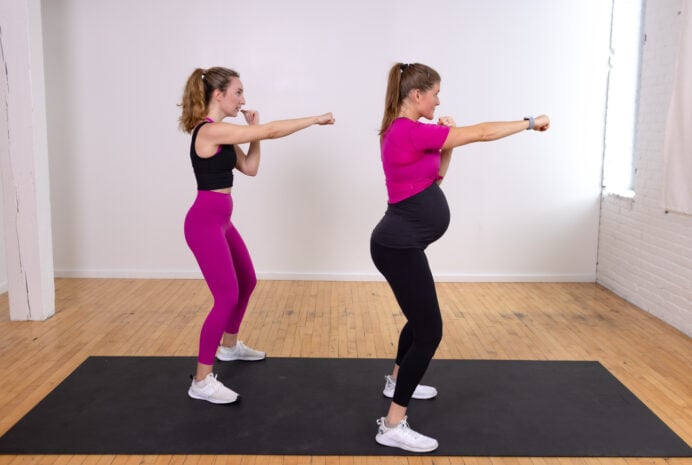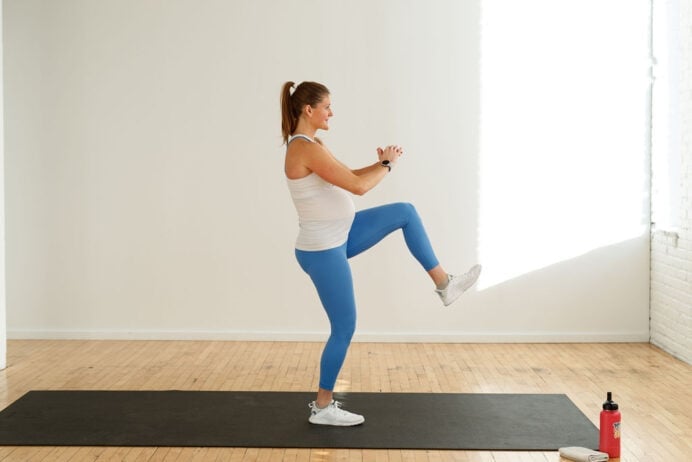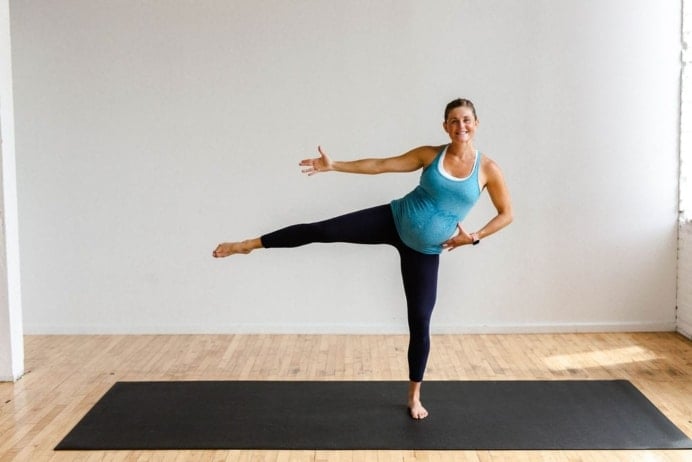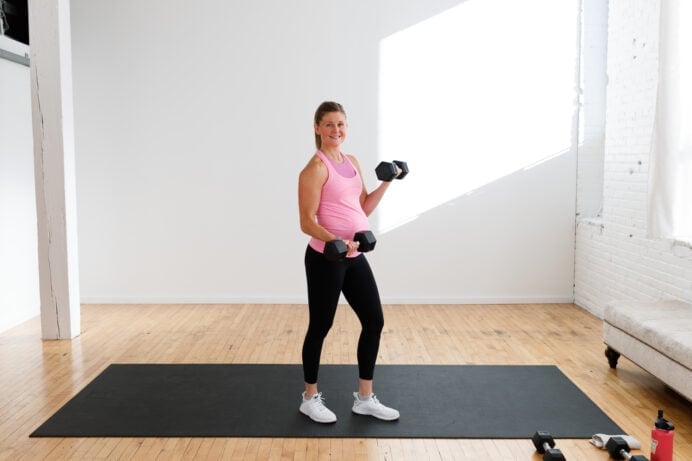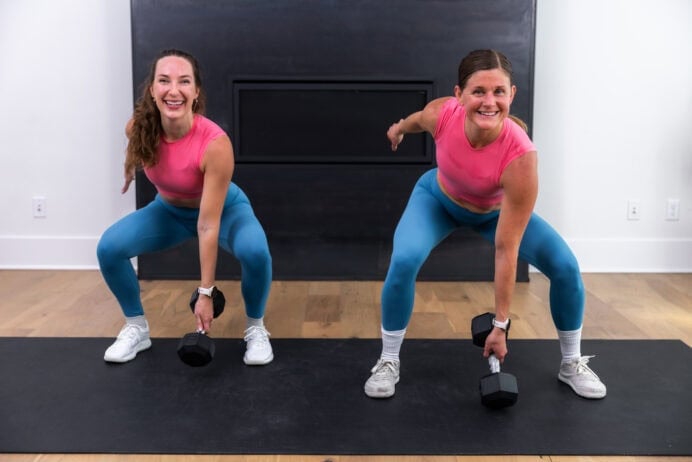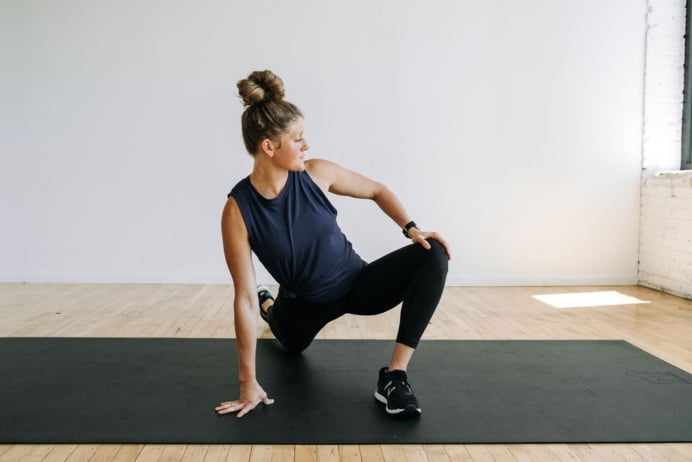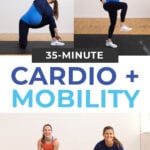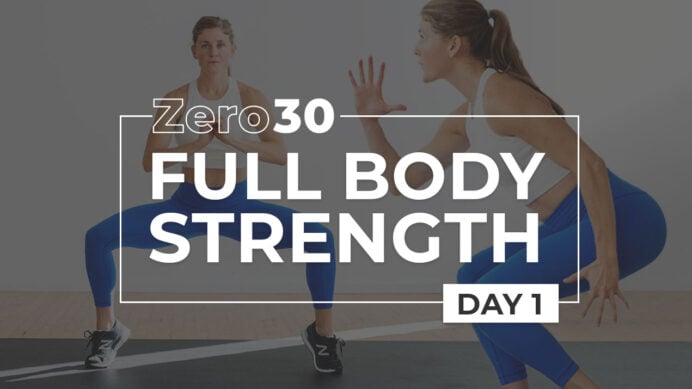
35-Minute Prenatal Cardio and Mobility Workout
A low-impact cardio workout that pairs Tabata intervals with full-body mobility exercises—designed to raise your heart rate and increase flexibility and range of motion. This workout is safe for all trimesters of pregnancy, but also a great workout for anyone looking for a low-impact cardio workout at home.
This was one of my go-to pregnancy workouts—especially during my third pregnancy. I did this prenatal cardio routine once a week, usually toward the end of the week when I needed something energizing but doable.
It’s mentally engaging, fast-paced, and easy to modify based on how much energy I have that day.
I believe that stretching and mobility are essential to a well-rounded fitness routine—but they’re often the first things I skip when I’m short on time. That said, they’re so important during pregnancy… particularly if you’re struggling with pain in the back, hips and adductors.
That’s why I built the mobility work right into this fun, Tabata-style cardio workout—so it’s something you’ll actually want to do, even as your bump grows.
Do this Prenatal Cardio and Mobility Workout if you want to:
- Raise your heart rate using just your bodyweight
- Get a good sweat without being super sore
- Improve cardiovascular endurance AND mobility
When exercising during pregnancy, listen to your body and take additional rest time as needed.
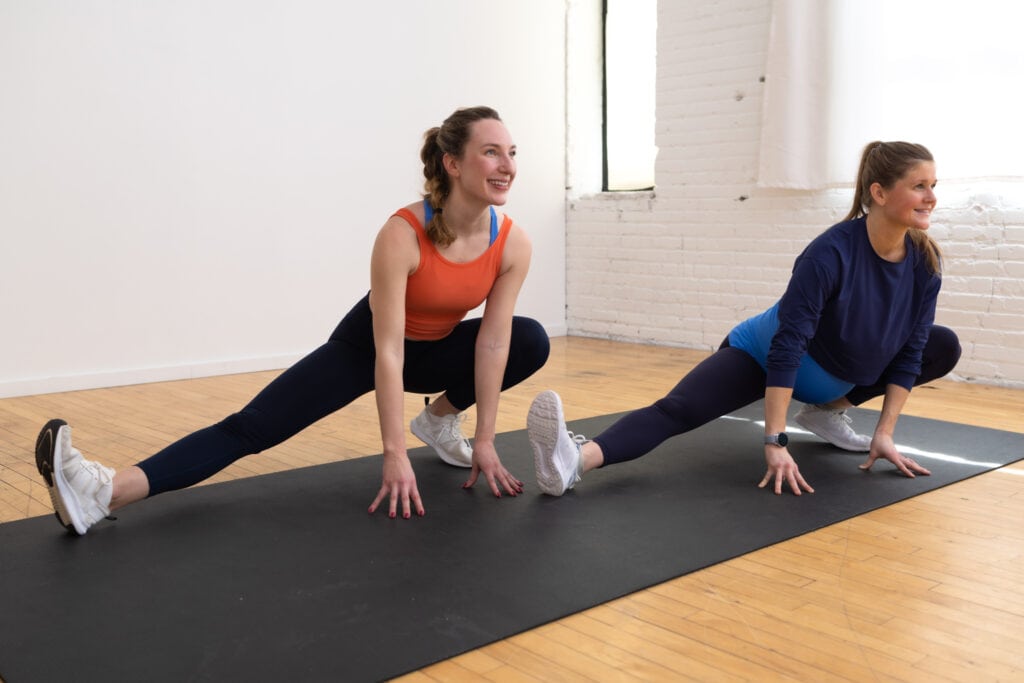
Workout Insights
A full body prenatal cardio workout that combines low impact, but high intensity, cardio Tabata intervals with full body mobility and stretching exercises.
Increase cardiovascular conditioning, improve full body mobility and decrease pregnancy back pain – all in a way that’s friendly on the joints and pelvic floor.
Add this cardio and mobility workout to your pregnancy exercise routine 1-2 times a week to maintain endurance and mobility through the first trimester, second trimester and third trimester.
Workout Equipment:
No equipment needed. Option to add an exercise bench/box or chair to reduce abdominal pressure during planks and push ups as your pregnancy progresses. This can also help with balance as your center of gravity shifts with a growing belly.
Workout Instructions:
Follow along with the guided Prenatal Cardio and Mobility Workout on YouTube, led by me — your certified personal trainer, Lindsey Bomgren.
Your Workout Looks Like This:
- 5 Circuits (2 Tabata cardio exercises and one mobility exercise per circuit)
- Timed Intervals (Perform each cardio Tabata exercise for 20 seconds, followed by 10 seconds rest. Perform each mobility exercise for 50 seconds.)
- Repeat Each Circuit x4 Sets
- 50-Seconds Mobility Flow Between Circuits
Workout Outline
CIRCUIT ONE
1. Runner Squat
2. Crossbody Jab and Tap
Mobility: Sumo Squat and Alternating Shoulder Drops
CIRCUIT TWO
1. Alternating Knee Drives
2. Three Lateral Squats and Lateral Shuffle
Mobility: Cossack Squats and Adductor Stretch
CIRCUIT THREE
1. Incline Plyo Push Up
2. Plank Step Up and Knee Drive
Mobility: Chest Expansion Stretch
CIRCUIT FOUR
1.Traveling High Knees
2. Loaded Lateral Squat Steps
Mobility: Half Kneeling Warrior IIs
CIRCUIT FIVE
1. Lateral Shuffle
2. Box Squat
Mobility: Hip Flexor Stretch and Hamstring Stretch
Alternating Knee Drives
Targets: Legs, glutes, quads, hamstrings, hip flexors, arms, back, shoulders and core.
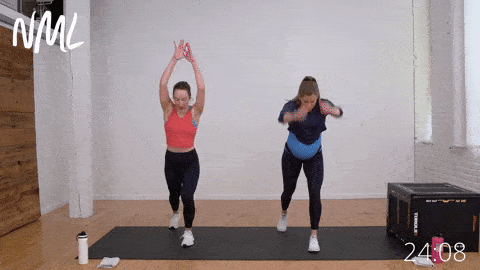
How To Do Alternating Knee Drives
- Start standing in a neutral position, feet hip-width apart. Step your right foot back into a reverse lunge.
- Quickly pull the right knee towards your chest before tapping it back behind you.
- Step or hop to alternate legs, sending your left leg back in a reverse lunge behind you.
- Quickly pull the left knee towards your chest before tapping it back behind you.
- Repeat, alternating each knee drive.
Three Lateral Squats and Lateral Shuffle
Targets: Glutes (gluteus medius), quads, hip adductors (inner thighs), hamstrings and core.
Focusing on the outer glutes or hip abductors that assist with side-to-side movements, as well as, stabilizing your pelvic floor.
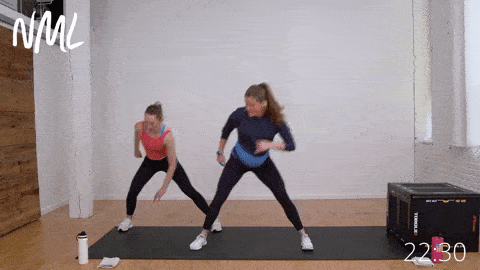
How To Do Three Lateral Squats and Lateral Shuffle
- Start standing, feet wider than shoulder-width (lateral squat stance), with toes facing forward or slightly turned out. Hold one dumbbell in your left hand.
- Sit your hips back, bending your right knee while leaving your left leg straight. Think of performing a single leg squat with your right leg while your left leg remains straight.
- Rapidly push to the left side, bending your left knee while leaving your right leg straight. Think of performing a single leg squat with your left leg while your right leg remains straight.
- Push to the right side once more, performing your third lateral squat.
- Then, perform a large shuffle to the left side of your mat, staying low and loaded through your legs.
- Land softly, and immediately sit your hips back and to the left, performing a lateral squat on the left. Repeat twice more, performing a right lateral squat, then ending with a left lateral squat.
- Then, perform a large lateral shuffle to the right side of your mat.
Cossack Squats and Adductor Stretch
Targets: Hip, knee, and ankle mobility. As well as increases flexibility in the hamstrings and adductors (inner thighs).
A great mobility exercise to help improve range of motion in the lower body and hips.
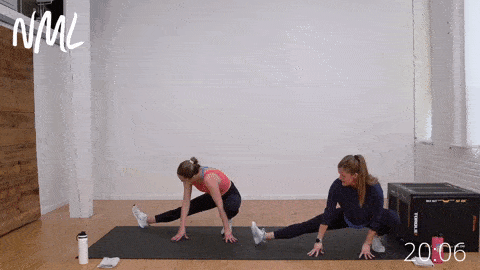
How To Do Cossack Squats and Adductor Rotations
- Start in a wide forward fold, feet outside of hips, toes pointing forward, fingertips touching the mat.
- Shift your hips back and to the left. Left leg creates a 90-degree angle, right leg is straight.
- Rotate your right leg open, so your toes point up towards the ceiling. Feel a stretch in your hips (inner thighs). Then bring your toes back to the mat.
- Shift to the opposite side, crawling your fingers over to the right as you sit back into your right hip. Right leg at a 90-degree angle, left leg straight.
- Rotate your left leg open, pointing your left toes up towards the ceiling.
Lateral Shuffle
Targets: Legs, glutes, quads, hamstrings, hip abductors and core.
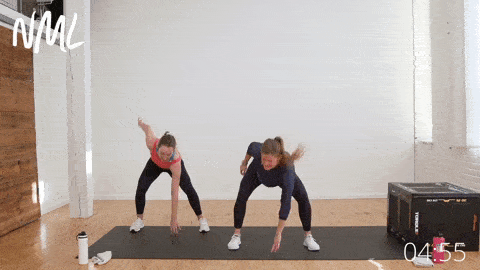
How To Do A Lateral Shuffle
- Start in an athletic stance, feet hip-width and knees bent, core braced.
- Perform a large shuffle to the left side of your mat, staying low and loaded through your legs.
- As you shuffle, bring your right hand down, aiming to tap the mat.
- Then, reverse the movement, shuffling to the right, bringing your left hand to tap the mat.
Box Squat
Targets: Legs, glutes, quadriceps (thighs), hamstrings, calves and core.
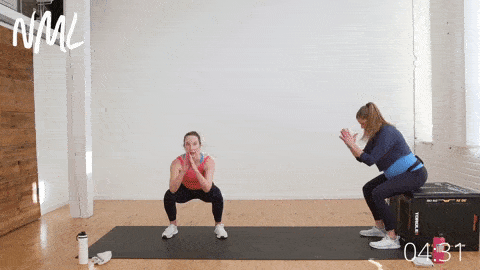
How To Do A Box Squat
- Start standing in front of your box or bench, feet shoulder-width distance apart, knees slightly bent, core engaged.
- Lower down into a squat position, lowering your hips down to tap your glutes to the box behind you. Both knees bent at 90 degrees.
- Drive through your heels to stand tall, squeezing your glutes.
- As you stand, perform a calf raise by lifting your heels off the ground.
Modification: Perform an air squat with a calf raise
Hip Flexor Stretch
Targets: Hips, hip flexors, groin, quads, glutes, low back and core.
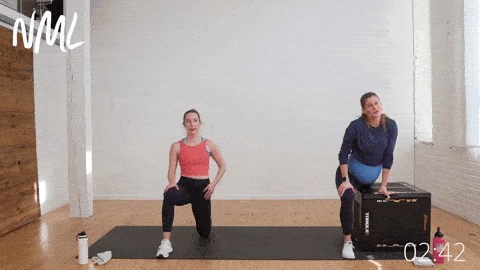
How To Do A Hip Flexor Stretch
- Start in a low lunge position with your left leg forward, right leg extended behind you, supported on a bench or couch. Left foot is planted on the ground.
- Square your hips to the front by tucking your tailbone. Bend your left knee, aiming for about a 90-degree angle. Think about feeling a gentle stretch in your right hip by tucking your pelvis rather than dumping into the low back.
- To further intensify the stretch, add a spinal rotation by looking over your left shoulder.
FAQs
Yes, ideally pregnant women should get at least 150 minutes of moderate-intensity aerobic activity every week (American College of Obstetricians and Gynecologists). This prenatal cardio workout qualifies as moderate intensity aerobics. I also suggest adding this 15-Minute Prenatal Bodyweight Workout and 35-Minute Low Impact Cardio Workout At Home to your pregnancy workout plan.
If you exercised regularly pre-pregnancy, there’s no need to focus on your heart rate during pregnancy (Mayo Clinic). Some providers used to recommend a heart rate under 140 bpm, but this advice is considered outdated now. Talk to your health care provider about your specific pregnancy’s needs before beginning any exercise.
Maintaining a regular exercise routine during pregnancy can reduce common aches/pains and help you maintain strength to prepare for labor. Physical activity can reduce risk of pregnancy complications like gestational diabetes, bloating, swelling and back pain.
Prenatal Cardio
More Prenatal CardioPin This Workout: Low Impact Cardio and Mobility Workout
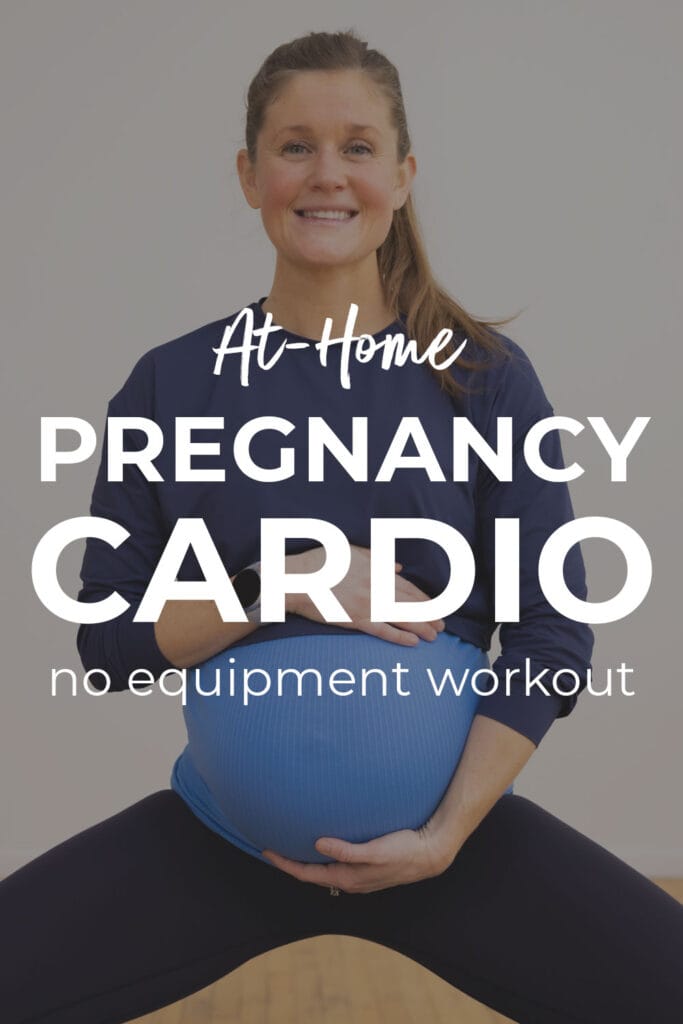
This post includes affiliate links. I do earn a commission for products purchased using these links (at no additional cost to you). Thank you for supporting Nourish Move Love, making the content you see on this blog possible.










